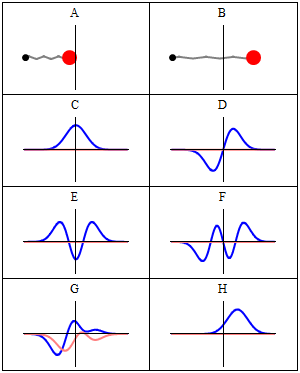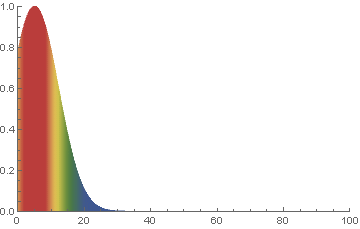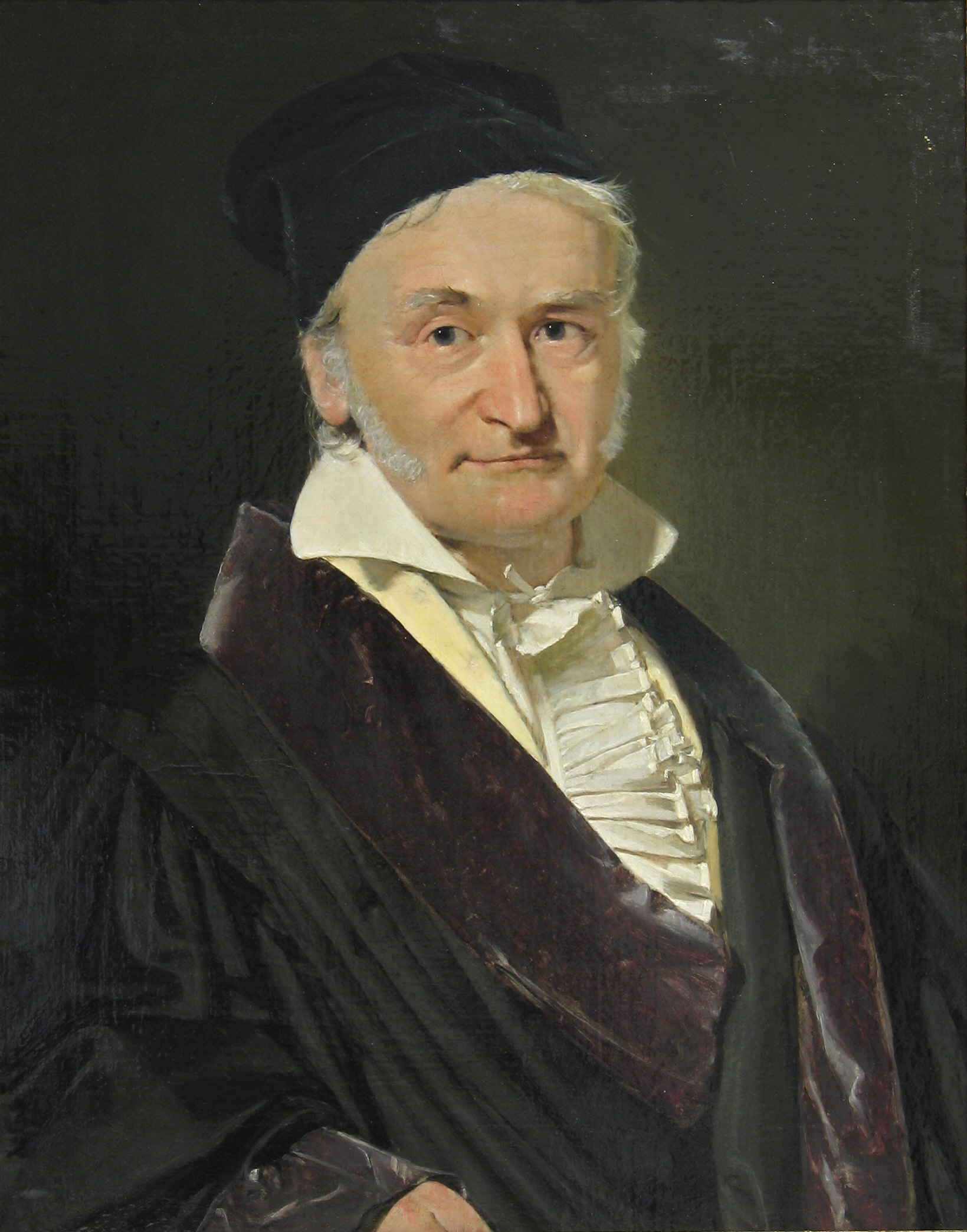|
Hermite Polynomials
In mathematics, the Hermite polynomials are a classical orthogonal polynomial sequence. The polynomials arise in: * signal processing as Hermitian wavelets for wavelet transform analysis * probability, such as the Edgeworth series, as well as in connection with Brownian motion; * combinatorics, as an example of an Appell sequence, obeying the umbral calculus; * numerical analysis as Gaussian quadrature; * physics, where they give rise to the eigenstates of the quantum harmonic oscillator; and they also occur in some cases of the heat equation (when the term \beginxu_\end is present); * systems theory in connection with nonlinear operations on Gaussian noise. * random matrix theory in Gaussian ensembles. Hermite polynomials were defined by Pierre-Simon Laplace in 1810, though in scarcely recognizable form, and studied in detail by Pafnuty Chebyshev in 1859. Chebyshev's work was overlooked, and they were named later after Charles Hermite, who wrote on the polynomials in ... [...More Info...] [...Related Items...] OR: [Wikipedia] [Google] [Baidu] [Amazon] |
|
 |
Quantum Harmonic Oscillator
The quantum harmonic oscillator is the quantum-mechanical analog of the classical harmonic oscillator. Because an arbitrary smooth potential can usually be approximated as a harmonic potential at the vicinity of a stable equilibrium point, it is one of the most important model systems in quantum mechanics. Furthermore, it is one of the few quantum-mechanical systems for which an exact, analytical solution is known. One-dimensional harmonic oscillator Hamiltonian and energy eigenstates The Hamiltonian of the particle is: \hat H = \frac + \frac k ^2 = \frac + \frac m \omega^2 ^2 \, , where is the particle's mass, is the force constant, \omega = \sqrt is the angular frequency of the oscillator, \hat is the position operator (given by in the coordinate basis), and \hat is the momentum operator (given by \hat p = -i \hbar \, \partial / \partial x in the coordinate basis). The first term in the Hamiltonian represents the kinetic energy of the particle, and the second ... [...More Info...] [...Related Items...] OR: [Wikipedia] [Google] [Baidu] [Amazon] |
 |
Heat Equation
In mathematics and physics (more specifically thermodynamics), the heat equation is a parabolic partial differential equation. The theory of the heat equation was first developed by Joseph Fourier in 1822 for the purpose of modeling how a quantity such as heat diffuses through a given region. Since then, the heat equation and its variants have been found to be fundamental in many parts of both pure and applied mathematics. Definition Given an open subset of and a subinterval of , one says that a function is a solution of the heat equation if : \frac = \frac + \cdots + \frac, where denotes a general point of the domain. It is typical to refer to as time and as spatial variables, even in abstract contexts where these phrases fail to have their intuitive meaning. The collection of spatial variables is often referred to simply as . For any given value of , the right-hand side of the equation is the Laplace operator, Laplacian of the function . As such, the heat equation is ... [...More Info...] [...Related Items...] OR: [Wikipedia] [Google] [Baidu] [Amazon] |
|
Expected Value
In probability theory, the expected value (also called expectation, expectancy, expectation operator, mathematical expectation, mean, expectation value, or first Moment (mathematics), moment) is a generalization of the weighted average. Informally, the expected value is the arithmetic mean, mean of the possible values a random variable can take, weighted by the probability of those outcomes. Since it is obtained through arithmetic, the expected value sometimes may not even be included in the sample data set; it is not the value you would expect to get in reality. The expected value of a random variable with a finite number of outcomes is a weighted average of all possible outcomes. In the case of a continuum of possible outcomes, the expectation is defined by Integral, integration. In the axiomatic foundation for probability provided by measure theory, the expectation is given by Lebesgue integration. The expected value of a random variable is often denoted by , , or , with a ... [...More Info...] [...Related Items...] OR: [Wikipedia] [Google] [Baidu] [Amazon] |
|
|
Normal Distribution
In probability theory and statistics, a normal distribution or Gaussian distribution is a type of continuous probability distribution for a real-valued random variable. The general form of its probability density function is f(x) = \frac e^\,. The parameter is the mean or expectation of the distribution (and also its median and mode), while the parameter \sigma^2 is the variance. The standard deviation of the distribution is (sigma). A random variable with a Gaussian distribution is said to be normally distributed, and is called a normal deviate. Normal distributions are important in statistics and are often used in the natural and social sciences to represent real-valued random variables whose distributions are not known. Their importance is partly due to the central limit theorem. It states that, under some conditions, the average of many samples (observations) of a random variable with finite mean and variance is itself a random variable—whose distribution c ... [...More Info...] [...Related Items...] OR: [Wikipedia] [Google] [Baidu] [Amazon] |
|
 |
Probability Density Function
In probability theory, a probability density function (PDF), density function, or density of an absolutely continuous random variable, is a Function (mathematics), function whose value at any given sample (or point) in the sample space (the set of possible values taken by the random variable) can be interpreted as providing a ''relative likelihood'' that the value of the random variable would be equal to that sample. Probability density is the probability per unit length, in other words, while the ''absolute likelihood'' for a continuous random variable to take on any particular value is 0 (since there is an infinite set of possible values to begin with), the value of the PDF at two different samples can be used to infer, in any particular draw of the random variable, how much more likely it is that the random variable would be close to one sample compared to the other sample. More precisely, the PDF is used to specify the probability of the random variable falling ''within ... [...More Info...] [...Related Items...] OR: [Wikipedia] [Google] [Baidu] [Amazon] |
|
Abramowitz & Stegun
''Abramowitz and Stegun'' (''AS'') is the informal name of a 1964 mathematical reference work edited by Milton Abramowitz and Irene Stegun of the United States National Bureau of Standards (NBS), now the National Institute of Standards and Technology (NIST). Its full title is ''Handbook of Mathematical Functions with Formulas, Graphs, and Mathematical Tables''. A digital successor to the Handbook was released as the "Digital Library of Mathematical Functions" (DLMF) on 11 May 2010, along with a printed version, the ''NIST Handbook of Mathematical Functions'', published by Cambridge University Press. Overview Since it was first published in 1964, the 1046-page ''Handbook'' has been one of the most comprehensive sources of information on special functions, containing definitions, identities, approximations, plots, and tables of values of numerous functions used in virtually all fields of applied mathematics. The notation used in the ''Handbook'' is the '' de facto'' standard for ... [...More Info...] [...Related Items...] OR: [Wikipedia] [Google] [Baidu] [Amazon] |
|
|
Rodrigues' Formula
In mathematics, Rodrigues' formula (formerly called the Ivory–Jacobi formula) generates the Legendre polynomials. It was independently introduced by , and . The name "Rodrigues formula" was introduced by Heine in 1878, after Hermite pointed out in 1865 that Rodrigues was the first to discover it. The term is also used to describe similar formulas for other orthogonal polynomials. describes the history of the Rodrigues formula in detail. Statement Let (P_n(x))_^\infty be a sequence of orthogonal polynomials on the interval , b/math> with respect to weight function w(x). That is, they have degrees deg(P_n) = n, satisfy the orthogonality condition \int_a^b P_m(x) P_n(x) w(x) \, dx = K_n \delta_ where K_n are nonzero constants depending on n, and \delta_ is the Kronecker delta. The interval , b/math> may be infinite in one or both ends. More abstractly, this can be viewed through Sturm–Liouville theory. Define an operator Lf := - \frac (Wf')', then the differential eq ... [...More Info...] [...Related Items...] OR: [Wikipedia] [Google] [Baidu] [Amazon] |
|
|
Classical Orthogonal Polynomials
In mathematics, the classical orthogonal polynomials are the most widely used orthogonal polynomials: the Hermite polynomials, Laguerre polynomials, Jacobi polynomials (including as a special case the Gegenbauer polynomials, Chebyshev polynomials, and Legendre polynomials). They have many important applications in such areas as mathematical physics (in particular, the theory of random matrices), approximation theory, numerical analysis, and many others. Classical orthogonal polynomials appeared in the early 19th century in the works of Adrien-Marie Legendre, who introduced the Legendre polynomials. In the late 19th century, the study of continued fractions to solve the moment problem by Pafnuty Chebyshev, P. L. Chebyshev and then Andrey Markov, A.A. Markov and Thomas Joannes Stieltjes, T.J. Stieltjes led to the general notion of orthogonal polynomials. For given polynomials Q, L: \R \to \R and \forall\,n \in \N_0 the classical orthogonal polynomials f_n:\R \to \R are characteriz ... [...More Info...] [...Related Items...] OR: [Wikipedia] [Google] [Baidu] [Amazon] |
|
 |
Charles Hermite
Charles Hermite () FRS FRSE MIAS (24 December 1822 – 14 January 1901) was a French mathematician who did research concerning number theory, quadratic forms, invariant theory, orthogonal polynomials, elliptic functions, and algebra. Hermite polynomials, Hermite interpolation, Hermite normal form, Hermitian operators, and cubic Hermite splines are named in his honor. One of his students was Henri Poincaré. He was the first to prove that '' e'', the base of natural logarithms, is a transcendental number. His methods were used later by Ferdinand von Lindemann to prove that is transcendental. Life Hermite was born in Dieuze, Moselle, on 24 December 1822, with a deformity in his right foot that would impair his gait throughout his life. He was the sixth of seven children of Ferdinand Hermite and his wife, Madeleine née Lallemand. Ferdinand worked in the drapery business of Madeleine's family while also pursuing a career as an artist. The drapery business relocated to Nan ... [...More Info...] [...Related Items...] OR: [Wikipedia] [Google] [Baidu] [Amazon] |
 |
Pafnuty Chebyshev
Pafnuty Lvovich Chebyshev ( rus, Пафну́тий Льво́вич Чебышёв, p=pɐfˈnutʲɪj ˈlʲvovʲɪtɕ tɕɪbɨˈʂof) ( – ) was a Russian mathematician and considered to be the founding father of Russian mathematics. Chebyshev is known for his fundamental contributions to the fields of probability, statistics, mechanics, and number theory. A number of important mathematical concepts are named after him, including the Chebyshev inequality (which can be used to prove the weak law of large numbers), the Bertrand–Chebyshev theorem, Chebyshev polynomials, Chebyshev linkage, and Chebyshev bias. Transcription The surname Chebyshev has been transliterated in several different ways, like Tchebichef, Tchebychev, Tchebycheff, Tschebyschev, Tschebyschef, Tschebyscheff, Čebyčev, Čebyšev, Chebysheff, Chebychov, Chebyshov (according to native Russian speakers, this one provides the closest pronunciation in English to the correct pronunciation in old Russian ... [...More Info...] [...Related Items...] OR: [Wikipedia] [Google] [Baidu] [Amazon] |
 |
Pierre-Simon Laplace
Pierre-Simon, Marquis de Laplace (; ; 23 March 1749 – 5 March 1827) was a French polymath, a scholar whose work has been instrumental in the fields of physics, astronomy, mathematics, engineering, statistics, and philosophy. He summarized and extended the work of his predecessors in his five-volume Traité de mécanique céleste, ''Mécanique céleste'' (''Celestial Mechanics'') (1799–1825). This work translated the geometric study of classical mechanics to one based on calculus, opening up a broader range of problems. Laplace also popularized and further confirmed Isaac Newton, Sir Isaac Newton's work. In statistics, the Bayesian probability, Bayesian interpretation of probability was developed mainly by Laplace. Laplace formulated Laplace's equation, and pioneered the Laplace transform which appears in many branches of mathematical physics, a field that he took a leading role in forming. The Laplace operator, Laplacian differential operator, widely used in mathematic ... [...More Info...] [...Related Items...] OR: [Wikipedia] [Google] [Baidu] [Amazon] |
 |
Gaussian Ensemble
Carl Friedrich Gauss (1777–1855) is the eponym of all of the topics listed below. There are over 100 topics all named after this German mathematician and scientist, all in the fields of mathematics, physics, and astronomy. The English eponymous adjective ''Gaussian'' is pronounced . Mathematics Algebra and linear algebra Geometry and differential geometry Number theory Cyclotomic fields *Gaussian period *Gaussian rational *Gauss sum, an exponential sum over Dirichlet characters ** Elliptic Gauss sum, an analog of a Gauss sum **Quadratic Gauss sum Analysis, numerical analysis, vector calculus and calculus of variations Complex analysis and convex analysis *Gauss–Lucas theorem *Gauss's continued fraction, an analytic continued fraction derived from the hypergeometric functions * Gauss's criterion – described oEncyclopedia of Mathematics*Gauss's hypergeometric theorem, an identity on hypergeometric series *Gauss plane Statistics *Gauss–Kuzmin d ... [...More Info...] [...Related Items...] OR: [Wikipedia] [Google] [Baidu] [Amazon] |